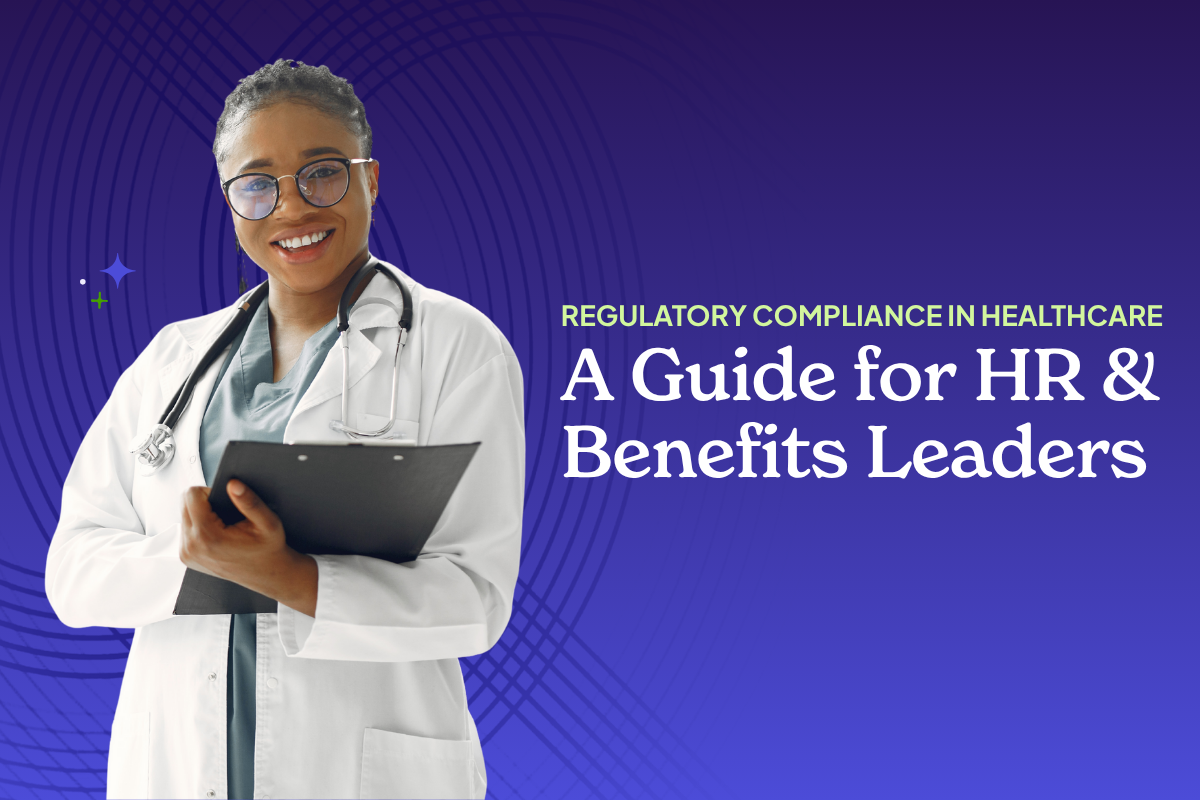Regulatory Compliance in Healthcare: A Guide for HR and Benefits Leaders

Few industries face as much scrutiny, or as many moving targets, as healthcare. From HIPAA privacy rules to ACA reporting requirements, compliance has become a constant pressure for HR and benefits leaders. It’s not just about checking boxes. It’s about protecting patients, safeguarding employee data, avoiding costly penalties, and ensuring the organization can withstand the next audit or regulatory change.
The reality is that compliance touches every corner of healthcare operations. It influences how you store and share information, how you handle billing and benefits, how you support your workforce, and how you prepare for emerging risks like cybersecurity threats or telehealth expansion. For leaders in HR and benefits, the challenge is especially complex: compliance isn’t confined to clinical care. It extends to every policy, platform, and communication you manage for employees.
In this guide, we’ll explain what “regulatory compliance in healthcare” really means, highlight the most important laws and regulations shaping the industry, and explore best practices to help HR and benefits leaders stay ahead. Along the way, we’ll share real-world examples, outline common pitfalls, and show how the right technology can turn compliance from a headache into a strategic advantage.
What Is Regulatory Compliance in Healthcare?
At its simplest, regulatory compliance in healthcare means following the laws, standards, and guidelines that govern how organizations deliver care, protect data, and support employees. But in practice, it’s far from simple. The healthcare industry is one of the most heavily regulated environments in the U.S., with requirements spanning privacy, workplace safety, billing practices, employee benefits, and more.
For HR and benefits leaders, compliance often centers on three big goals:
- Protecting information – Safeguarding employee and patient data under rules like HIPAA and HITECH.
- Ensuring fair and accurate benefits administration – Meeting ACA requirements for reporting, eligibility, and affordability.
- Maintaining a safe, lawful workplace – Staying aligned with OSHA, CMS, and other oversight bodies.
Non-compliance can come at a steep price. Regulators issue millions of dollars in fines each year for violations ranging from mishandled data to incomplete ACA filings. Just as damaging are the reputational risks and loss of trust that follow a compliance failure. For organizations that already operate under tight margins and workforce pressure, these costs can be devastating.
That’s why understanding and staying ahead of regulatory compliance in the healthcare industry is more than a legal obligation. It’s a strategic priority that directly affects your organization’s ability to attract and retain staff, deliver quality care, and manage risk with confidence.
Why It’s More Than Just HIPAA: The Expanding Scope of Healthcare HR Compliance
When most people hear “healthcare compliance,” their first thought is HIPAA. And for good reason—HIPAA sets the standard for protecting sensitive health information. But for HR and benefits leaders, compliance extends far beyond medical records. It’s an intrinsic part of how leaders support employee health and finances.
Today’s healthcare organizations must navigate a wide spectrum of regulatory requirements:
- ACA (Affordable Care Act): Employers must accurately track hours, report coverage, and ensure benefits meet affordability and eligibility standards.
- CMS (Centers for Medicare & Medicaid Services): From billing integrity to coverage rules, CMS compliance impacts both patient care and employer-sponsored plans.
- OSHA (Occupational Safety and Health Administration): Workplace safety mandates apply to healthcare facilities just as much as to construction sites, with added complexity given exposure risks in clinical settings.
- HITECH and cybersecurity rules: As telehealth expands and benefits platforms go digital, organizations are under growing pressure to protect against data breaches and cyberattacks.
The consequences of falling short in are not hypothetical. In recent years, hospitals and health systems have faced fines in the millions for improper billing, mismanaged ACA filings, or preventable data breaches. UCLA Health, for example, paid $7.5 million after a HIPAA violation exposed the records of over 4.5 million patients. And in 2019, the American Medical Collection Agency (AMCA) filed for bankruptcy following a breach that compromised the data of 25 million individuals.
Focusing only on HIPAA leaves serious blind spots. Regulatory compliance in the healthcare industry is interconnected, and vulnerabilities in one area can quickly cascade into others. Staying compliant means building processes (and adopting tools) that address the full landscape of obligations, not just the most obvious ones.
Core Compliance Areas Healthcare Employers Must Manage
It would be nice if healthcare compliance were one big box to check, but it’s far more complex than that. Instead, it’s a network of requirements that touch nearly every aspect of the employee experience. That said, for HR and benefits leaders, several areas consistently rise to the top in ACA compliance strategies:
ACA Reporting and Benefits Administration
The Affordable Care Act (ACA) requires employers to provide accurate reporting on employee eligibility, hours worked, and coverage offered. Filing mistakes or missed deadlines can result in costly penalties from the IRS. Automated tools can streamline 1094/1095 reporting, simplify delivery to employees, and help ensure benefits remain affordable and compliant year after year.
Data Privacy and Security
HIPAA and HITECH establish strict standards for protecting personal health information (PHI), but compliance isn’t only about patient records—it extends to employee benefits data too. HR leaders must ensure systems for enrollment, communication, and recordkeeping are secure and auditable, reducing the risk of breaches or unauthorized access.
Workplace Safety and Employee Wellbeing
OSHA requirements are especially critical in healthcare, where workplace injuries and exposure risks are higher than in most industries. HR plays a role in reinforcing compliance through training, communication, and clear documentation—while also ensuring benefits programs support employee health and resilience.
Multi-State and Federal Mandates
Many healthcare organizations operate across state lines, adding another layer of complexity for ACA compliance services. HR teams must keep pace with varying state-level rules on leave, insurance coverage, and employment law, while ensuring compliance with CMS and other federal standards.
Common Examples of Regulatory Compliance in Healthcare
Real-world cases show just how costly and disruptive compliance failures can be. A few notable examples:
- UCLA Health HIPAA Breach (2015): Hackers accessed the records of 4.5 million patients. The organization paid a $7.5 million settlement and faced long-term reputational damage.
- American Medical Collection Agency (AMCA) Data Breach (2019): A billing services vendor compromised data for 25 million patients, leading to bankruptcy and widespread lawsuits for healthcare providers.
- Anthem ACA Reporting Penalties (2017): One of the largest U.S. insurers faced millions in fines for inaccurate and incomplete ACA filings, highlighting the complexity of benefits reporting.
- OSHA Citations for Hospital Safety Violations: Hospitals across the country have been fined for failing to provide adequate protections against bloodborne pathogens, workplace violence, and ergonomic risks.
These examples illustrate the breadth of regulatory compliance in the healthcare industry. They also show why HR and benefits leaders must view compliance not as a one-time project, but as an ongoing discipline.
Common Compliance Gaps for Healthcare HR Teams
Even well-resourced organizations struggle to keep pace with the shifting compliance landscape. For HR and benefits teams, several recurring gaps create risk:
- Manual, error-prone reporting: Reliance on spreadsheets or siloed systems increases the likelihood of mistakes in ACA filings, benefits eligibility tracking, and leave documentation.
- Inconsistent communication: Employees often miss critical updates about benefit changes, eligibility rules, or safety protocols, creating compliance blind spots.
- Limited audit readiness: Documentation may exist, but it’s scattered across systems and hard to produce quickly during a regulatory review.
- Overlooking state-level rules: Multi-state employers risk fines when state mandates on leave, insurance coverage, or payroll reporting aren’t aligned with federal policies.
- Cybersecurity gaps: HR platforms and benefits data are increasingly attractive targets for hackers, but many organizations lack encryption, secure portals, or strong access controls.
Left unaddressed, these gaps will erode employee trust and create administrative headaches that drain already stretched HR teams.
Best Practices for Maintaining Compliance
Healthcare compliance requires ongoing attention, proactive monitoring, and a clear process for keeping both employees and regulators aligned. HR and benefits leaders can reduce risk by focusing on a few proven best practices:
- Centralize documentation: Store policies, benefit details, ACA filings, and OSHA training records in a single, secure location. This not only strengthens audit readiness but also reduces the chance of errors or omissions.
- Automate where possible: Use technology to handle repetitive, detail-heavy tasks like ACA reporting, 1095 delivery, or eligibility tracking. Automation minimizes human error and keeps you on schedule with filing deadlines.
- Train and communicate consistently: Employees are often the first line of defense in compliance, whether it’s safeguarding data or following safety protocols. Regular training and clear communication ensure they know their responsibilities.
- Monitor regulatory updates: Assign responsibility for tracking changes from HIPAA, ACA, CMS, and OSHA. Proactive monitoring helps avoid last-minute scrambles when new rules take effect.
- Benchmark against peers: Compare your policies and outcomes (such as turnover or benefits participation) with industry averages to spot gaps before they become liabilities.
Download our Healthcare Compliance Checklist for a step-by-step way to stay audit-ready.
By adopting these practices, HR leaders can turn compliance from a reactive chore into something more proactive, that supports employees, minimizes risk, and strengthens your organizational resilience.
How Technology Can Support Healthcare Compliance
Managing healthcare solutions and compliance manually is a recipe for risk. Regulations are too complex and change too often for HR and benefits teams to keep up with spreadsheets and ad hoc processes. The right technology can ease the burden and give leaders confidence that compliance is being handled consistently.
Key advantages of compliance technology include:
- Automated reporting: Tools that generate and file ACA forms (1094/1095) on time, every time, help organizations avoid costly IRS penalties.
- Secure data handling: Centralized, encrypted systems protect sensitive employee and patient information while keeping audit trails intact.
- Simplified communication: Integrated platforms make it easier to deliver timely updates about benefits, safety requirements, or eligibility changes across the workforce.
- Multi-state support: Automated systems can track variations in state rules and ensure policies remain aligned with federal standards.
- Audit readiness: Technology organizes documentation and reporting in one place, so HR leaders can respond quickly when regulators come calling.
At Selerix, we design solutions that help healthcare employers reduce compliance complexity. From ACA reporting and benefits communication to secure data management, our tools give HR and compliance leaders the visibility and confidence they need to stay ahead.
Explore our Healthcare Compliance Solutions to see how we can support your team.
Turn Compliance Chaos into Operational Confidence
Regulatory compliance in healthcare can feel overwhelming, but it doesn’t have to. With the right processes and technology in place, HR and benefits leaders can shift from playing defense to leading with confidence. Instead of scrambling to keep up with HIPAA, ACA, OSHA, and CMS requirements, you can build a system that ensures compliance is routine, employees are informed, and your organization is always audit-ready.
That’s the difference between compliance as a burden and compliance as a real advantage.
At Selerix, we help healthcare organizations simplify the complexity. From ACA reporting to secure communication tools, our solutions are built to protect your data, reduce risk, and support the people who keep your organization running.
Ready to simplify compliance?
Download our free Healthcare Compliance Checklist to see the key steps every HR and benefits leader should take to stay audit-ready. Fill out the form below to download your free copy:

